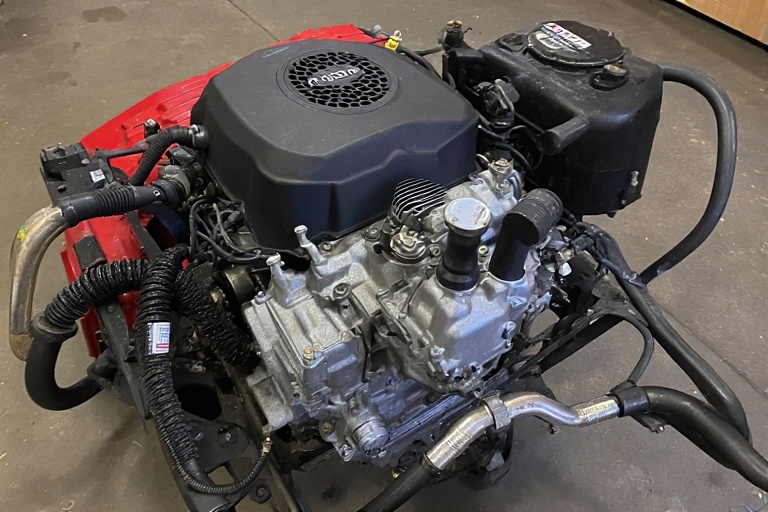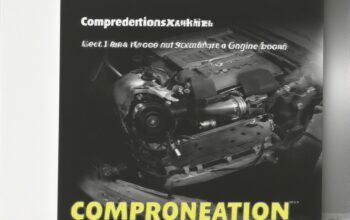
Maintaining your Briggs and Stratton engine 123K02 is essential for ensuring optimal performance and longevity, and one critical aspect of this maintenance is the Briggs and Stratton engine 123K02 breather hose cleaning. The breather hose plays a vital role in regulating crankcase pressure, preventing oil leaks, and ensuring smooth engine operation. A clogged or dirty breather hose can lead to issues like oil leaks, reduced engine efficiency, or even severe engine damage. This article provides a step-by-step guide to Briggs and Stratton engine 123K02 breather hose cleaning, offering practical tips, tools required, and expert insights to keep your engine running smoothly.
Understanding the Role of the Breather Hose in the Briggs and Stratton Engine 123K02
The breather hose in the Briggs and Stratton engine 123K02 is a critical component of the crankcase ventilation system. It allows excess pressure and gases to escape from the crankcase while preventing contaminants like dirt and debris from entering. This ensures the engine operates efficiently, maintains proper oil levels, and avoids pressure buildup that could force oil out through seals or gaskets. Regular Briggs and Stratton engine 123K02 breather hose cleaning prevents clogs that can disrupt this balance, leading to problems such as blue or white smoke, oil leaks, or reduced power output.
Neglecting the breather hose can result in serious consequences. For instance, a clogged breather hose may cause excessive crankcase pressure, pushing oil through the breather tube or other engine components. This can damage the air filter, reduce fuel efficiency, or even cause piston ring wear. By prioritizing Briggs and Stratton engine 123K02 breather hose cleaning, you can avoid these issues and extend the life of your engine.
Why Briggs and Stratton Engine 123K02 Breather Hose Cleaning Is Essential
Regular cleaning of the breather hose in the Briggs and Stratton engine 123K02 is crucial for several reasons:
- Prevents Oil Leaks: A clogged breather hose can cause pressure buildup, forcing oil out through seals, gaskets, or the breather tube itself. Proper Briggs and Stratton engine 123K02 breather hose cleaning ensures oil stays where it belongs.
- Maintains Engine Efficiency: A clean breather hose allows proper ventilation, reducing strain on the engine and improving fuel efficiency.
- Extends Engine Life: By preventing contaminants from entering the crankcase, Briggs and Stratton engine 123K02 breather hose cleaning protects internal components like piston rings and valve seals from premature wear.
- Reduces Emissions: A well-maintained breather hose minimizes the risk of oil burning, which can produce blue or white smoke, ensuring compliance with emission standards.
Tools and Materials Needed for Briggs and Stratton Engine 123K02 Breather Hose Cleaning
Before starting the Briggs and Stratton engine 123K02 breather hose cleaning process, gather the following tools and materials:
- Screwdriver or Socket Wrench: To remove the breather assembly cover.
- Briggs & Stratton Heavy-Duty Degreaser: For cleaning the hose and breather assembly (part number 100044).
- Clean Cloths or Rags: To wipe away dirt, oil, and debris.
- Replacement Breather Hose (if needed): Ensure compatibility with the Briggs and Stratton engine 123K02 (e.g., part number 692253 or 794683).
- Small Brush or Pipe Cleaner: To scrub the inside of the breather hose.
- Gloves and Safety Glasses: To protect against oil and debris.
- Container for Waste Oil: For safe disposal of any spilled oil.
- Owner’s Manual: To verify model-specific instructions for the Briggs and Stratton engine 123K02.
Having these tools ready ensures a smooth and efficient Briggs and Stratton engine 123K02 breather hose cleaning process.
Step-by-Step Guide to Briggs and Stratton Engine 123K02 Breather Hose Cleaning
Follow these detailed steps to perform Briggs and Stratton engine 123K02 breather hose cleaning effectively:
Step 1: Prepare the Engine
Ensure the engine is off, cooled to ambient temperature, and placed in a well-ventilated area. Disconnect the spark plug to prevent accidental starts during the Briggs and Stratton engine 123K02 breather hose cleaning process. Refer to your owner’s manual to locate the breather hose, typically found near the rear of the engine or connected to the air filter housing.
Step 2: Inspect the Breather Hose
Locate the breather hose on the Briggs and Stratton engine 123K02. Check for visible signs of wear, cracks, or oil residue. A clogged or damaged hose may appear oily, brittle, or discolored. If the hose is severely damaged, consider replacing it with a genuine Briggs and Stratton part (e.g., part number 794683) to ensure compatibility.
Step 3: Remove the Breather Assembly
Using a screwdriver or socket wrench, remove the screws securing the breather assembly cover. Carefully lift the cover to access the breather hose and valve. Take note of the gasket and reed valve, as these components are critical to the breather system’s function. During Briggs and Stratton engine 123K02 breather hose cleaning, inspect these parts for wear or damage.
Step 4: Clean the Breather Hose
Detach the breather hose from the engine and air filter housing. Spray Briggs & Stratton Heavy-Duty Degreaser liberally inside and outside the hose. Use a small brush or pipe cleaner to scrub away oil, dirt, or debris buildup. Rinse the hose with water, ensuring no degreaser residue remains, and dry thoroughly with a clean cloth. Proper Briggs and Stratton engine 123K02 breather hose cleaning ensures all contaminants are removed.
Step 5: Inspect and Clean the Breather Valve
Check the breather valve (reed valve) for sludge or restricted movement. Soak the valve in kerosene or a degreaser if it’s gummed up, ensuring the valve disc moves freely. Avoid disassembling the valve unless necessary, as this can damage delicate components. Cleaning the valve is a key part of Briggs and Stratton engine 123K02 breather hose cleaning to maintain proper crankcase ventilation.
Step 6: Reassemble the Breather System
Reattach the cleaned or new breather hose to the engine and air filter housing. Ensure the hose is securely connected to prevent air leaks. Reinstall the breather assembly cover, gasket, and screws, tightening them to the torque specifications outlined in the Briggs and Stratton engine 123K02 manual. Double-check all connections to ensure a tight seal.
Step 7: Test the Engine
Reconnect the spark plug and start the engine. Observe for any signs of oil leaks, unusual smoke, or reduced performance. A successful Briggs and Stratton engine 123K02 breather hose cleaning should result in smooth operation, no oil leaks, and no smoke from the exhaust.
Tips for Preventing Breather Hose Issues in the Briggs and Stratton Engine 123K02
To minimize the need for frequent Briggs and Stratton engine 123K02 breather hose cleaning, follow these preventive maintenance tips:
- Use the Correct Oil: Always use the oil type and viscosity recommended by Briggs and Stratton to prevent excessive oil consumption or pressure buildup.
- Check Oil Levels Regularly: Overfilling the crankcase can force oil through the breather hose. Maintain the correct oil level as indicated on the dipstick.
- Perform Regular Maintenance: Schedule routine oil changes and air filter replacements to keep the engine clean and reduce stress on the breather system.
- Avoid Operating on Steep Slopes: Running the engine on a steep incline can cause oil to flow into the breather hose, leading to clogs.
- Inspect for Wear: Periodically check the breather hose and valve for signs of wear or damage during routine maintenance.
By following these tips, you can reduce the frequency of Briggs and Stratton engine 123K02 breather hose cleaning and maintain optimal engine performance.
Common Symptoms of a Clogged Breather Hose in the Briggs and Stratton Engine 123K02
A clogged breather hose can cause several noticeable symptoms in the Briggs and Stratton engine 123K02. Recognizing these signs early can prompt timely Briggs and Stratton engine 123K02 breather hose cleaning:
- Oil Leaks: Oil escaping from seals, gaskets, or the breather tube itself.
- Blue or White Smoke: Indicates oil burning due to excessive crankcase pressure.
- Reduced Engine Power: A clogged breather hose can disrupt the air-fuel ratio, leading to sluggish performance.
- Oil-Soaked Air Filter: Oil forced through the breather hose can contaminate the air filter, reducing efficiency.
- Increased Oil Consumption: A blocked breather hose may cause the engine to burn or leak oil.
If you notice any of these symptoms, prioritize Briggs and Stratton engine 123K02 breather hose cleaning to prevent further damage.
Conclusion
The Briggs and Stratton engine 123K02 breather hose cleaning is a vital maintenance task that ensures your engine runs smoothly, efficiently, and reliably. By keeping the breather hose clean, you prevent oil leaks, maintain proper crankcase ventilation, and extend the life of your engine. This guide provides a clear, step-by-step process for Briggs and Stratton engine 123K02 breather hose cleaning, along with preventive tips to minimize future issues. Regular maintenance, combined with the use of genuine Briggs and Stratton parts, will keep your engine in top condition for years to come. Make Briggs and Stratton engine 123K02 breather hose cleaning a part of your routine maintenance schedule to avoid costly repairs and ensure peak performance.
FAQs
1. How often should I perform Briggs and Stratton engine 123K02 breather hose cleaning?
It’s recommended to inspect and clean the breather hose during routine maintenance, typically every 50-100 hours of engine use or annually, depending on usage and operating conditions.
2. Can I use a non-Briggs and Stratton breather hose for replacement?
While aftermarket parts may fit, using genuine Briggs and Stratton parts (e.g., part number 794683) ensures compatibility and optimal performance for the Briggs and Stratton engine 123K02.
3. What happens if I don’t clean the breather hose regularly?
Neglecting Briggs and Stratton engine 123K02 breather hose cleaning can lead to oil leaks, reduced engine efficiency, increased oil consumption, and potential damage to internal components like piston rings or seals.
4. How do I know if the breather hose is damaged and needs replacement?
Inspect the hose for cracks, brittleness, or heavy oil residue. If it’s damaged or cannot be cleaned thoroughly, replace it during the Briggs and Stratton engine 123K02 breather hose cleaning process.
5. Can a clogged breather hose cause my engine to smoke?
Yes, a clogged breather hose can cause excessive crankcase pressure, forcing oil into the combustion chamber, resulting in blue or white smoke. Regular Briggs and Stratton engine 123K02 breather hose cleaning can prevent this issue.



